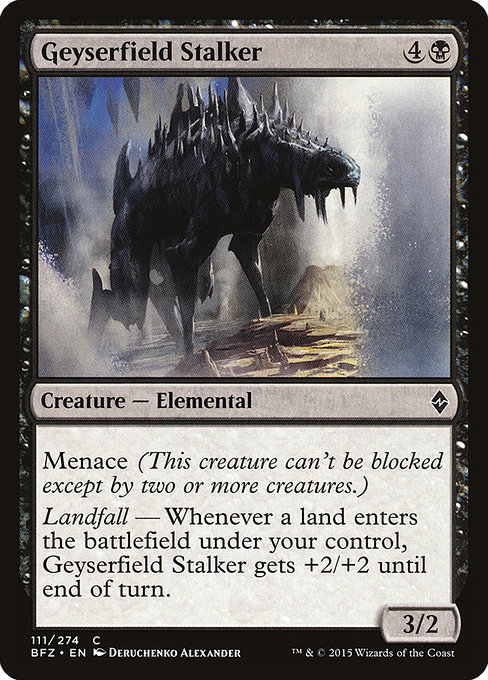
Image courtesy of Scryfall.com
Mana Efficiency in Black: A Data-Driven Look at Geyserfield Stalker
For fans who chase the exact moment when tempo and value collide, Geyserfield Stalker is a neat case study. This Battles-for-Zendikar common arrives with a robust silhouette: a 5-mana investment for a 3/2 creature that sneers with Menace and hides a Landfall kicker that can swing the entire tempo of a game. In the right shell, this card can turn a one-turn swing into a cascade of pressure, especially when land plays compound with the buff. The data-driven question is simple: how often does the Landfall trigger land you a meaningful attack on the next swing, and how often is that swing enough to tilt the game? 🧙♂️🔥
- Name: Geyserfield Stalker
- Mana Cost: {4}{B} (CMC 5)
- Type: Creature — Elemental
- Power/Toughness: 3/2
- Keywords: Menace, Landfall
- Rarity: Common
- Set: Battle for Zendikar (BFZ)
- Artist: Deruchenko Alexander
From a gameplay standpoint, the card’s mana efficiency hinges on two intersecting axes: the menace-enabled combat dynamics and the Landfall-triggered buff. On the front end, you’re paying five mana for a 3/2 body—adequate, but not spectacular by itself. The real spark is the land-enter event: whenever a land you control enters the battlefield, this creature gains +2/+2 until end of turn. That single, conditional pump turns a potentially underwhelming threat into a sudden problem for blockers and a source of surprising pressure when the buff lands on a turn where you already have a board presence. It’s a reminder that “mana efficiency” isn’t just about raw stats; it’s about the timing and the leverage you gain from the battlefield state. ⚡🎲
Data-driven evaluation asks: what is the average impact per landfall event? Since the buff is +2/+2 until end of turn, the Stalker can spike from a 3/2 to a 5/4 on the turn a land enters, provided you can keep it alive and rely on Menace to threaten multiple angles of attack. In practice, this means that in midrange or lean black landfall shells, you’re not just deploying a blocker or a dork—you’re setting up a temporary alpha strike where your opponent must decide how to allocate resources to survive multiple lethal lines. The payoff grows when you enable multiple landfall triggers in a single turn through fetches, land-search effects, or synergy with cards that generate extra lands entering the battlefield. 🧙♂️🔥💎
Moreover, the card’s data profile highlights a broader design truth: common cards with a high-leverage ability can disproportionately affect game tempo when integrated into the right deck. Geyserfield Stalker’s Landfall ability is a classic example of how a seemingly modest body can morph into a tempo engine when supported by the right ecosystem of lands and effects. The card’s availability as a common means it’s accessible to a wide swath of players, making it a touchstone for budget-conscious decks that still crave tactical depth. The BFZ art by Deruchenko Alexander anchors the card in a volcanic, drama-filled moment—an aesthetic reminder that data and story can share the same battlefield. 🎨
“Landfall isn’t just a gimmick; it’s a tempo engine that can bend turns around a single, well-timed drop.”
From a design perspective, the Stalker also highlights a recurring theme in Magic: the value of conditional buffs that scale with the board state. In black color identity, a creature like this can anchor a midrange plan that leverages disruption and pressure, with the Landfall trigger acting as a built-in force multiplier on your best turns. It’s not just about landing a big hit; it’s about creating an unpredictable pattern of attacks that your opponent can’t easily anticipate or block. And yes, for collectors and players who love BFZ-era flavor, the card’s common status belies a surprising depth on the table and in the data sets that analyze tempo and efficiency. 🧙♂️🎯
For builders aiming to maximize the data-driven potential of Geyserfield Stalker, the route is clear: pair it with reliable land-entry sources, optimize your mana base to ensure you hit payoff turns, and lean into the menace factor to pressure blockers that bog down your plan. This is where the “mana efficiency” label truly shines—it's not just about paying a certain amount of mana, but about converting each drop into a meaningful, tempo-heavy impact that influences decision points in the game. When the numbers line up with the battlefield, your Stalker isn’t just a creature—it’s a recurring reminder that a single land drop can alter the trajectory of a match. 🧙♂️🔥
Rugged Phone Case — Impact Resistant TPU/PC (iPhone & Samsung)Image courtesy of Scryfall.com
More from our network
- https://blog.digital-vault.xyz/blog/post/top-tools-to-automate-your-digital-storefront/
- https://blog.digital-vault.xyz/blog/post/distant-hot-blue-star-confirms-cluster-membership-by-proper-motion/
- https://transparent-paper.shop/blog/post/measuring-parallax-illuminates-a-32000-k-blue-white-beacon-in-circinus/
- https://blog.rusty-articles.xyz/blog/post/using-flux-in-token-decks-strategies-and-synergies/
- https://blog.digital-vault.xyz/blog/post/machine-learning-optimizes-ride-the-avalanche-deck/